This article has been
cited by other articles in ScienceCentral.
Abstract
Background
In 2013, Infection & Chemotherapy changed the main language of its articles to English so that they could be submitted to PubMed Central. This study presents the recent status of journal metrics for Infection & Chemotherapy and introduces scholarly journal publishing policies or guidelines that have recently appeared.
Materials and Methods
A variety of journal metrics were analyzed based on the Web of Science Core Collection, including the nationality of authors the proportion of funded articles to original articles , manually calculated impact factor, the titles of journals in which articles were cited”, and the Hirsch index.
Results
Out of 181 articles of Infection & Chemotherapy published between 2015 and 2018, the highest number of authors were from Korea (165, 91.2%). There were articles from 11 other countries. The proportion of funded articles to original articles has increased yearly and has reached 46.7% in 2018. The manually calculated impact factor of the year 2017 was 1.728, which corresponded to 21.5% of the 2017 Journal Citation Reports (JCR) category of “infectious diseases”. There were 196 source journal titles that cited Infection & Chemotherapy in the 2015–2018 issues. The Hirsch index was 15.
Conclusion
The metrics results above demonstrate that over the years, Infection & Chemotherapy was developed into a top-level international-level journal so that it could be utilized by researchers across the world. The adoption of new policies including author taxonomy, an open data policy, a clinical data sharing policy, the principles of transparency and best practice in scholarly publishing 3rd edition will help increase the transparency of the authorship and the scientific integrity of the articles.
Go to :

Keywords: Information dissemination, Journal impact factor, Language, Republic of Korea, Scholarly communication
Introduction
Infection & Chemotherapy (ISSN: 2093-2340) is the official journal of both the Korean Society of Infectious Diseases and the Korean Society for Chemotherapy. It has been a continuation of the journal Kamyŏmgwa hwahak yopŏp (ISSN: 1598-8112), which started in 2003 and ended in 2009,
Infection & Chemotherapy is the result of a merge between Taehan Hwahak Yopŏp Hakhoe chi (=
The Journal of the Korean Society for Chemotherapy, ISSN: 1225-7850) which started in 1983 and ended in 2002 and Kamyŏm (=
Korean Journal of Infectious Diseases, ISSN: 0368-6221) which started in 1969 and ended in 2002.
Infection & Chemotherapy is the typical model in Korea for a merger between two society journals. It changed the main language of its articles into English from 2013 onwards so that they could be submitted to PubMed Central after the production of full-text JATS XML files [
1]. Furthermore, it is searchable from PubMed. Its content has been also searchable from the Web of Science Core Collection in the Emerging Sources Citation Index database since its 2015 issues and from Scopus since its 2011 issues. Therefore, one can rightly claim that it is an international journal. I would like to present the recent status of journal metrics for
Infection & Chemotherapy to confirm its present position as an international journal, and furthermore, to introduce the recent publishing policies or guidelines to better transparency of authorship and scientific integrity.
Go to :

Materials and Methods
As for journal metrics, the following will be analyzed from the Web of Science Core Collection: the number of citable and non-citable articles, the nationality of authors, the nationality of editorial board members, the proportion of funded articles to original articles, total citations, the manually calculated impact factor [
2], the authors' countries and source title of the articles which cited
Infection & Chemotherapy, and the Hirsch index [
3]. The definition of the impact factor is given as the “impact factor of the journal J in the year X = A/B, where A is the number of total citations in the year X received by all items published in the journal J in the years (X−1) and (X−2) and B is the total number of all citable items published in the journal J in the years (X−1) and (X−2). Citable items include only papers and reviews and do not include errata, editorials, and abstracts. In the counting of A, however, citations to all items published in J are included” [
2]. The Hirsch index is defined as “the number of papers with citation number ≥h, and it has index h if h of its Np papers have at least h citations each, and the other (Np–h) papers have ≤h citations each” [
3].
Recent policy or standards that were introduced included author taxonomy, an open data policy, a clinical data sharing policy, and the “principles of transparency and best practice in scholarly publishing 3rd edition”.
Go to :

Results
1. Journal metrics
The number of citable and non-citable articles is presented in
Fig. 1. Out of 181 articles, the highest number of authors are from Korea (165, 91.2%). There are articles from 11 other countries (
Fig. 2). Out of 51 editorial board members, 30 members are from Korea (
Fig. 3). 21 members are from 16 other countries. The proportion of funded articles to original articles has increased yearly to reach 46.7% in 2018 (
Fig. 4). Total citations increased yearly (
Fig. 5). The number of citable articles from 2015 to 2016 was 81 and the number of citations in 2017 in the articles published between 2015 and 2016 was 140. Therefore, the manually calculated impact factor of 2017 was 1.728 (140/81). The number of countries that cited articles of the 2015–2018 issues of
Infection & Chemotherapy was 60. Korea, the United States of America, and China were the top 3 countries that cited the journal (
Fig. 6). The 196 source journal titles that cited the 2015–2018 issues of
Infection & Chemotherapy are presented in
Fig. 7. Out of 346 citing articles, 49 (14.2%) were from
Infection & Chemotherapy. The Hirsch index can be obtained from
Table 1 which shows the most frequently cited articles published from 2003. A total of 582 articles had been cited in the Web of Science Core Collection. The Hirsch index is 15 (
Table 1).
 | Figure 1Number of citable and non-citable articles of Infection & Chemotherapy from 2015 to June 2015.
|
 | Figure 2The countries of authors who published in Infection & Chemotherapy from 2015 to 2018.
|
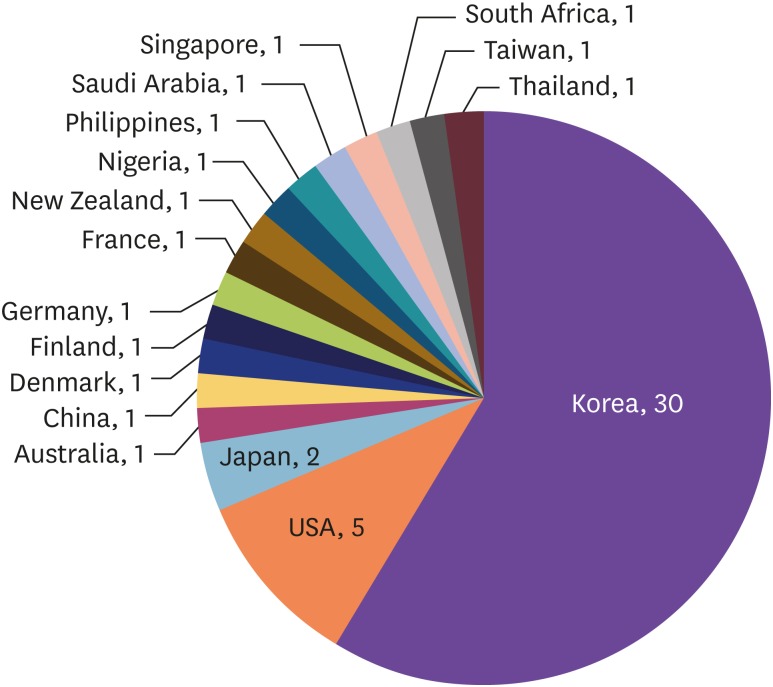 | Figure 3Countries of editorial board members of Infection & Chemotherapy in 2018.
|
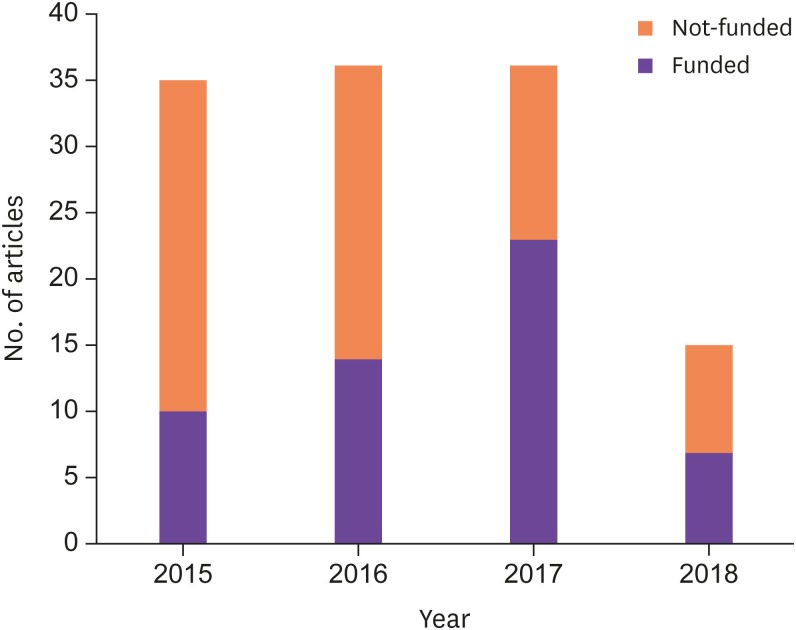 | Figure 4The number of funded and non-funded articles out of original articles in Infection & Chemotherapy.
|
 | Figure 5Total citations of Infection & Chemotherapy in the Web of Science Core Collection [cited 2018 Aug 6].
|
 | Figure 6The countries of authors who cited the 2015–2016 issues of Infection & Chemotherapy in Web of Science Core Collection [cited 2018 Aug 6].
|
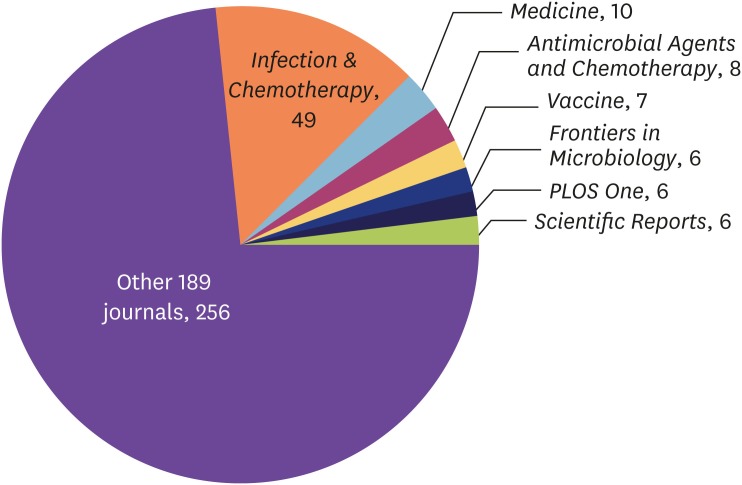 | Figure 7Source journal titles that cited the 2015–2018 issues of Infection & Chemotherapy in Web of Science Core Collection [cited 2018 Aug 6].
|
Table 1
Most frequently cited articles of Infection & Chemotherapy out of 582 cited articles from 2003
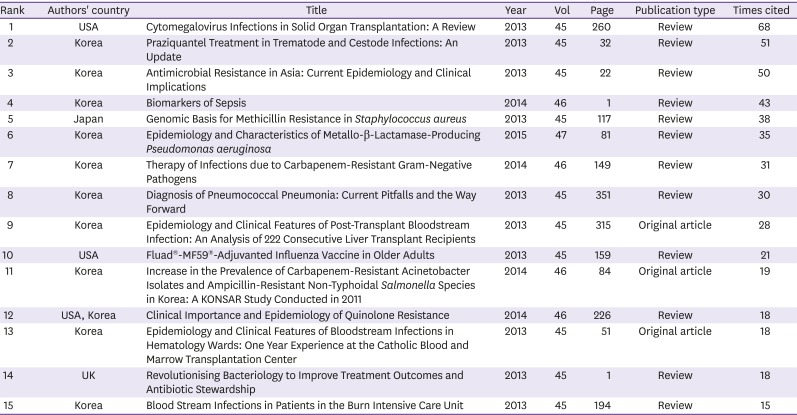
|
Rank |
Authors' country |
Title |
Year |
Vol |
Page |
Publication type |
Times cited |
|
1 |
USA |
Cytomegalovirus Infections in Solid Organ Transplantation: A Review |
2013 |
45 |
260 |
Review |
68 |
|
2 |
Korea |
Praziquantel Treatment in Trematode and Cestode Infections: An Update |
2013 |
45 |
32 |
Review |
51 |
|
3 |
Korea |
Antimicrobial Resistance in Asia: Current Epidemiology and Clinical Implications |
2013 |
45 |
22 |
Review |
50 |
|
4 |
Korea |
Biomarkers of Sepsis |
2014 |
46 |
1 |
Review |
43 |
|
5 |
Japan |
Genomic Basis for Methicillin Resistance in Staphylococcus aureus
|
2013 |
45 |
117 |
Review |
38 |
|
6 |
Korea |
Epidemiology and Characteristics of Metallo-β-Lactamase-Producing Pseudomonas aeruginosa
|
2015 |
47 |
81 |
Review |
35 |
|
7 |
Korea |
Therapy of Infections due to Carbapenem-Resistant Gram-Negative Pathogens |
2014 |
46 |
149 |
Review |
31 |
|
8 |
Korea |
Diagnosis of Pneumococcal Pneumonia: Current Pitfalls and the Way Forward |
2013 |
45 |
351 |
Review |
30 |
|
9 |
Korea |
Epidemiology and Clinical Features of Post-Transplant Bloodstream Infection: An Analysis of 222 Consecutive Liver Transplant Recipients |
2013 |
45 |
315 |
Original article |
28 |
|
10 |
USA |
Fluad®-MF59®-Adjuvanted Influenza Vaccine in Older Adults |
2013 |
45 |
159 |
Review |
21 |
|
11 |
Korea |
Increase in the Prevalence of Carbapenem-Resistant Acinetobacter Isolates and Ampicillin-Resistant Non-Typhoidal Salmonella Species in Korea: A KONSAR Study Conducted in 2011 |
2014 |
46 |
84 |
Original article |
19 |
|
12 |
USA, Korea |
Clinical Importance and Epidemiology of Quinolone Resistance |
2014 |
46 |
226 |
Review |
18 |
|
13 |
Korea |
Epidemiology and Clinical Features of Bloodstream Infections in Hematology Wards: One Year Experience at the Catholic Blood and Marrow Transplantation Center |
2013 |
45 |
51 |
Original article |
18 |
|
14 |
UK |
Revolutionising Bacteriology to Improve Treatment Outcomes and Antibiotic Stewardship |
2013 |
45 |
1 |
Review |
18 |
|
15 |
Korea |
Blood Stream Infections in Patients in the Burn Intensive Care Unit |
2013 |
45 |
194 |
Review |
15 |

2. New policies or guidelines
1) Author (contributor) taxonomy
In 2012, a group of journal editors met under the support of Harvard University and Welcome Trust. They discussed the descriptions of each author's role in the list of authors.
Nature published a commentary on author taxonomy in 2014 which mentioned that “through the endorsement of individuals' contributions, researchers can start to move beyond ‘authorship’ as the dominant measure of esteem” [
4]. Since 2014, author taxonomy – otherwise known as CRediT (Contributor Roles Taxonomy) – started to be adopted by journal editors and publishers. The authors' role was classified into 14 categories from conceptualization to writing-review and editing; these categories are available at:
https://casrai.org/credit/. In Korea, a number of journals including the
Journal of Educational Evaluation for Health Professions began to adopt author taxonomy in 2017 [
5]. An example is as follows:
Authors' contributions
Conceptualization: SH. Data curation: MKY. Formal analysis: EYL. Funding acquisition: SH. Methodology: EYL MKY SH. Project administration: SH. Visualization: EYL MKY SH. Writing - original draft: EYL. Writing - review & editing: EYL MKY SH.
This kind of description may be able to reduce disputes over authorship and give specific credit to each author. It is not necessary to adopt or describe all 14 categories. The range of description is dependent on the specific characteristics of the articles.
2) Open data policy
It was originally designed for the transparent presentation of public data supported or generated by the government. Therefore, it is also called “open public sector information” [
6]. It was first initiated by the United States of America and the European Union governments. The Korea government also adopted the open data policy for the databases generated by the government's budget after enacting the law “ACT ON PROMOTION OF THE PROVISION AND USE OF PUBLIC DATA” in November 19 2014, available at:
https://elaw.klri.re.kr/kor_service/lawView.do?hseq=47133&lang=ENG. Recently, this concept was introduced to scholarly journal publishing. At the 13th European Association of Science Editors' conference in Strasbourg, France in 2016, Lex M. Bouter proposed “increasing transparency with open data policies and modifications of the reward system for researchers in order to prevent questionable research practices or sloppy science” [
7]. In Korea, the
Journal of Educational Evaluation for Health Professions is a pioneer in its adoption of the open data policy in March 2016 [
8]. The open data policy was already introduced in the field of biomedical information; therefore, to publish articles on genes or proteins, researchers should deposit their data to GenBank or other related banks managed by the United States National Center for Biotechnology Information. These data can thus be used for review and further analysis by researchers in the same field. Depositing data and opening them up to other researchers can provide three benefits. First, scientific soundness can be guaranteed. If raw data are opened to reviewers and readers, the analysis of data can be repeated with the same methods more easily. Second, there is a possibility of developing new ideas through raw data; furthermore, this can initiate more advanced research in the same field. Third, raw data can facilitate meta-analysis or high quality systemic reviews through analysis. I am not sure to what extent raw data may be used by researchers because these three benefits are still under speculation. If a journal editor or publisher decides to adopt the open data policy, the depository of data is necessary. Currently, Harvard Dataverse is the first option for society journals [
9]. Until August 4 2018, 76 journals have made their own space for data deposition (
https://dataverse.harvard.edu/dataverse/harvard). There is no fee to deposit data. Figshare (
https://figshare.com/) is the other option for data deposition; however, it is not free.
3) ICMJE's data sharing statement policy
It is an open data policy. It was recommended by the
International Committee of Medical Journal Editors (ICMJE); therefore, all journal editors and publishers who state that they follow the ICMJE recommendations should follow this policy. From July 1 2018, manuscripts of clinical trials must announce a data-sharing statement. Editors should add this policy to their instructions to authors. There are options to specify the degree of data sharing statements by authors; therefore, authors can choose from the available options in the examples of data sharing statements which are available from this policy editorial [
10].
4) Principles of transparency and best practice in scholarly publishing 3rd ed.
This guideline was recently revised in January 2018. Therefore, there are few scholarly journals that adopt this guideline [
11]. It is composed of 16 items. Out of 10 scholarly journals published by Trakya University in Turkey, items of marketing, intellectual property, and data sharing were omitted[
12]. In Korea, there is still no survey on the compliance of these 16 items to scholarly journals.
Table 2 summarizes the 16 items. It is also mandatory to fulfill these 16 items before applying to be indexed in MEDLINE [
13].
Table 2
Compliance of a medical journal to the Principles of Transparency and Best Practice in Scholarly Publishing (joint statement by COPE, DOAJ, WAME, and OASPA; (http://doaj.org/bestpractice)
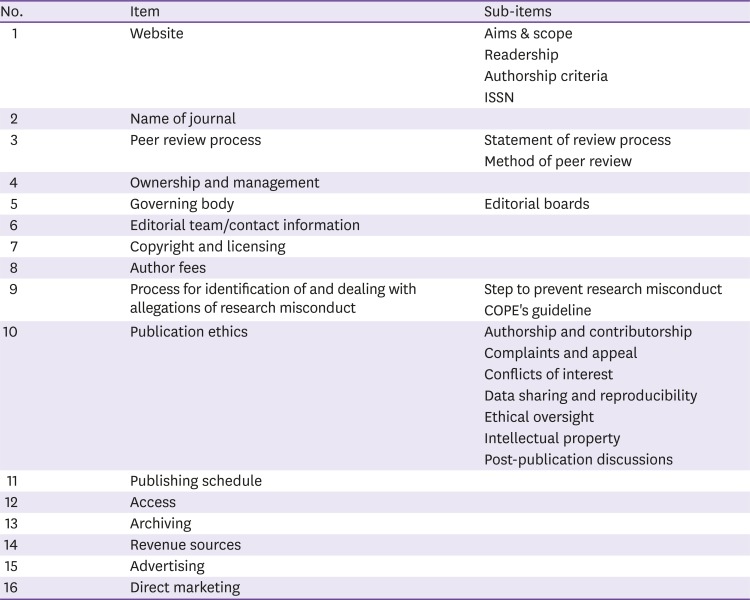
|
No. |
Item |
Sub-items |
|
1 |
Website |
Aims & scope |
|
Readership |
|
Authorship criteria |
|
ISSN |
|
2 |
Name of journal |
|
|
3 |
Peer review process |
Statement of review process |
|
Method of peer review |
|
4 |
Ownership and management |
|
|
5 |
Governing body |
Editorial boards |
|
6 |
Editorial team/contact information |
|
|
7 |
Copyright and licensing |
|
|
8 |
Author fees |
|
|
9 |
Process for identification of and dealing with allegations of research misconduct |
Step to prevent research misconduct |
|
COPE's guideline |
|
10 |
Publication ethics |
Authorship and contributorship |
|
Complaints and appeal |
|
Conflicts of interest |
|
Data sharing and reproducibility |
|
Ethical oversight |
|
Intellectual property |
|
Post-publication discussions |
|
11 |
Publishing schedule |
|
|
12 |
Access |
|
|
13 |
Archiving |
|
|
14 |
Revenue sources |
|
|
15 |
Advertising |
|
|
16 |
Direct marketing |
|

Go to :

Discussion
The metrics results above demonstrate the following. First, although Korean authors are dominant, Infection & Chemotherapy has been cited by 60 countries all over the world in 196 journals. Second, the proportion of funded articles has increased yearly. Third, citation has increased yearly and the recent impact factor corresponded to 21.5% of the Journal Citation Reports (JCR) category of infection. Fourth, review articles have been cited more frequently than original articles.
In fact, review articles have been cited more frequently than any other publication types in other journals in Korea, such as
Clinical and Molecular Hepatology [
14],
Clinical and Experimental Vaccine Research [
15],
Annals of Pediatric Endocrinology & Metabolism [
16],
Intestinal Research [
17], and
Neurointervention [
18]. Exceptions were present:
Clinics in Orthopedic Surgery, where all of the 15 highly-cited articles were original articles, except one [
19], and
Blood Research [
20], where out of 10 highly-cited articles, half the type of publication were review articles while the other half were original articles. These phenomena may be dependent on editors' decisions on how to recruit the invited review articles and from whom the review articles were submitted. In
Infection & Chemotherapy, Korean authors' review articles formed a major portion of all the highly-cited articles.
In conclusion, the metrics results tell us the present position of the journal in the international scholarly journal market. This was made possible by the authors' contribution which were mainly from society members, the editors' ceaseless devotion, and the publishing society's full support. One of the journal's present tasks is to recruit more invaluable manuscripts from outside Korea for a multinational authorship. The recent publication policies mentioned above are not difficult for editors to adopt or to describe more lucidly, which will be able to promote the transparency of authorship and the scientific integrity of the articles to the highest level.
Go to :

ACKNOWLEDGMENTS
This work was supported by the Hallym University Research Fund (HRF-201610-011).
Go to :

Notes
Go to :

References
1. Schwarzman AB. Journal article tag suite subset and Schematron: achieving the right balance. Sci Ed. 2018; 5:2–15.

2. Kim K, Chung Y. Overview of journal metrics. Sci Ed. 2018; 5:16–20.

3. Hirsch JE. An index to quantify an individual's scientific research output. Proc Natl Acad Sci U S A. 2005; 102:16569–16572. PMID:
16275915.

4. Allen L, Scott J, Brand A, Hlava M, Altman M. Publishing: credit where credit is due. Nature. 2014; 508:312–313. PMID:
24745070.

5. Lim EY, Yim MK, Huh S. Smart device-based testing for medical students in Korea: satisfaction, convenience, and advantages. J Educ Eval Health Prof. 2017; 14:7. PMID:
28835015.

6. Zuiderwijk A, Janssen M. Open data policies, their implementation and impact: A framework for comparison. Gov Inf Q. 2014; 31:17–29.

7. Huh S. What can Asian editors contribute to European editors? Sci Ed. 2016; 3:122–124.

8. Huh S. Promotion to MEDLINE, indexing with Medical Subject Headings, and open data policy for the journal of educational evaluation for health professions. J Educ Eval Health Prof. 2016; 13:14. PMID:
27030394.
9. Huh S. Establishment of an open data policy for Journal of Educational Evaluation for Health Professions, appreciation for invited reviewers, and acknowledgement of volunteers who made audio recordings. J Educ Eval Health Prof. 2017; 14:37. PMID:
29284767.
10. Taichman DB, Sahni P, Pinborg A, Peiperl L, Laine C, James A, Hong ST, Haileamlak A, Gollogly L, Godlee F, Frizelle FA, Florenzano F, Drazen JM, Bauchner H, Baethge C, Backus J. Data sharing statements for clinical trials: a requirement of the international committee of medical journal editors. J Korean Med Sci. 2017; 32:1051–1053. PMID:
28581257.

11. Huh S. Adherence of the
Annals of Pediatric Endocrinology & Metabolism to the
Principles of Transparency and Best Practice in Scholarly Publishing
. Ann Pediatr Endocrinol Metab. 2018; 23:1–3. PMID:
29609442.
12. Huh S. The 14th European Association of Science Editors Conference, Bucharest 2018. Sci Ed. 2018; 5:155–158.

13. Huh S. How to prepare Endocrinology and Metabolism for reapplication to MEDLINE. Endocrinol Metab. 2017; 32:58–61.
14. Huh S. Journal metrics of Clinical and Molecular Hepatology based on the Web of Science Core Collection. Clin Mol Hepatol. 2018; 24:137–143. PMID:
29961305.

15. Huh S.
Clinical and Experimental Vaccine Research's promotion to internationally competitive journal evidenced by journal metrics. Clin Exp Vaccine Res. 2017; 6:67–71. PMID:
28775970.
16. Huh S. The rapid internationalization of
Annals of Pediatric Endocrinology & Metabolism as evidenced by journal metrics. Ann Pediatr Endocrinol Metab. 2017; 22:77–81. PMID:
28690984.
17. Jeong GH, Huh S. The great rise of
Intestinal Research as an international journal 3 years after its language change to English as evidenced by journal metrics. Intest Res. 2017; 15:1–4. PMID:
28239311.
18. Huh S. Promotion of Neurointervention to international journal based on journal metrics. Neurointervention. 2016; 11:5–9. PMID:
26958406.
19. Huh S. Clinics in Orthopedic Surgery's evolution into an international journal based on journal metrics. Clin Orthop Surg. 2016; 8:127–132. PMID:
27247735.

20. Huh S. How much progress has
Blood Research made since the change of the journal title in 2013. Blood Res. 2018; 53:95–100. PMID:
29963510.
Go to :












 PDF
PDF ePub
ePub Citation
Citation Print
Print





 XML Download
XML Download